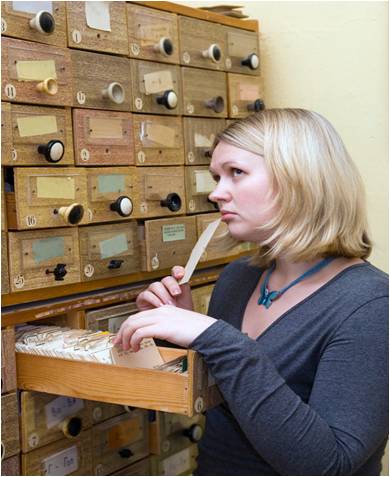
Library Resources

Once you have refined your topic, find relevant books and media by using the Library's catalog on its home page:
http://www.frederick.edu/student-resources/learning-commons/library.aspx (Of course, we no longer use a print card catalog as in the picture above. We have an electronic catalog, accessible online from anywhere!)
LIBRARY CATALOG
The catalog lists print books, electronic books, and DVDs in the Library.
Here is a short introduction to the Library Catalog. Click on the image below, and then scroll through the screens of the demo at your own pace. Then, just close the document to to get back here to the Orientation.
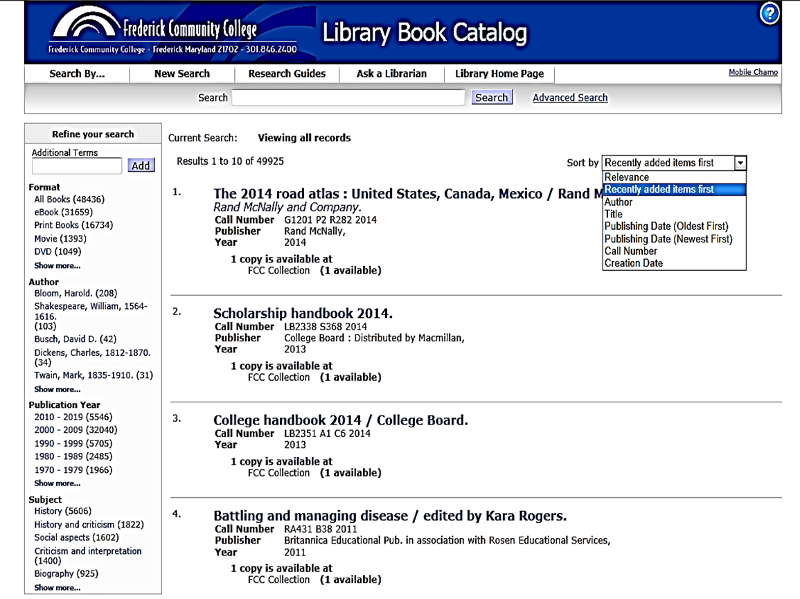
We use the Library of Congress (LC) system of call numbers in our Library. The call number is composed of letters and numbers and represents a certain subject area. If the item is a print, rather than electronic book, the call number serves as the "address" for that item on the
shelves. Below is a simplified guide to LC.
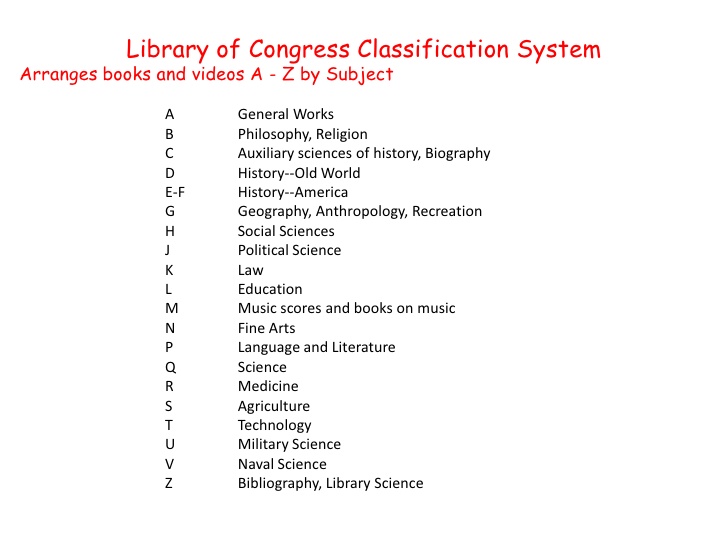
Here is an example of books arranged on a shelf by subject in Library of Congress class order:
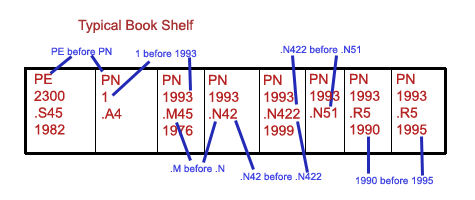
Here's an example of a book with a Library of Congress call number:
PN= Literature in general. PN 1993.45= Film Studies Literature A75= Represents the author's last name
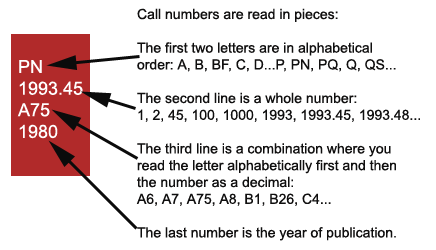

The ebrary database is the Library resource to use in order to retrieve electronic books only. We have seen in the examples above, that you can retrieve ebooks in the regular FCC Library catalog. However, the catalog will only search for your keywords in the Author, Title, Subject, and Notes area that describe an item. ebrary, on the other hand, enables you to search full-text. That means that it will look for your keywords on every page in every book that you retrieve in your search. It is more comprehensive, in other words.
To access this databases from off-campus:
Students: enter your myFCC Username and Password when prompted.
Your Default myFCC Username is the letter W plus your student ID number. (Example: W1234567)
If you haven't changed your password, your Default Password is the first two letters of your last name plus the last five digits of your student ID number (Example: sm34567).
Faculty/Staff: Use your Network Username and Password when prompted.
EBRARY DEMO: ELECTRONIC BOOKS IN OUR COLLECTION
Be sure to wear headphones to hear the sound in the video below if you are in the Library.
Also, to see the full screen clearly, click on the YouTube logo on the bottom right, run your cursor along the bottom edge of the video screen, and click on the ![]() symbol. When you are finished viewing, close the YouTube tab to get back to this page.
symbol. When you are finished viewing, close the YouTube tab to get back to this page.
©2012 proquestvideo
The Library has style manuals to help you format your citations for the ebooks in eBRARY, there are guidelines for and examples of the different styles in the "Why and How to Give Credit" lesson in the Virtual Library Orientation, there is a section in our Writing Center Research Guide that can help, or you can submit an Ask a Reference Librarian form.
I've heard my instructor use the terms, "primary source" and "secondary source." What's the difference?
In general, a primary source is original material that has not been interpreted, condensed, or evaluated by a second party, while a secondary source somehow modifies or interprets that original material. The specific meaning, however, is slightly different in the humanities and in the sciences/social sciences.
Primary Sources
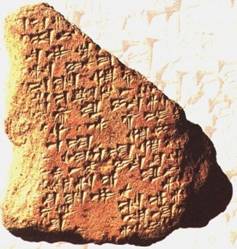
People use original, first-hand accounts as building blocks to create stories or articles. These accounts are called primary sources, because they are the first evidence that something is happening, or being thought, or said. Primary sources are created at the time of an event or very soon after something has happened. These sources are often rare or one-of-a-kind.
All of the following can be primary sources:
· Autobiographies
· Diaries
· Letters
· Photographs
· Art and artifacts
· Maps
· Video and film
· Sound recordings
· Interviews
· Newspapers
· Magazines
· Published eyewitness accounts
· Research articles in scholarly journals
Examples of primary sources:
The Adventures of Huckleberry Finn--Novel
The Constitution of the United States--Document of U.S. history
Plato's Republic--Political/philosophical document
Historic Egyptian furniture and pottery
Narratives of the Insurrections, 1675-1690--Documents from Bacon's rebellion
The Autobiography of a Winnebago Indian--Native American History
Secondary Sources
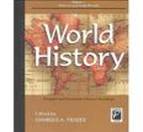
Second-hand, published accounts are called secondary sources. They are called secondary sources because they are created after primary sources, and they often use or discuss primary sources. Secondary sources often give additional opinions on or interpretations of an event or of a primary source.
All of the following can be secondary sources:
· Biographies
· History textbooks
· Published stories in popular magazines
· Movies of historical events
· Art reproductions
· Encyclopedias
Music recordings
Examples of secondary sources
Mark Twain's Huckleberry Finn by Barry Marks
The Constitution and What it Means Today by Edward Corwin
Lectures on the Republic of Plato by Richard Nettleship
Treasures of Tutankhamen by Katherine Gilbert
The Story of Bacon's Rebellion by Mary Stannard
The Winnebago Tribe by Paul Radin
1. Primary Sources
Generally, a primary source in these disciplines is one in which a researcher presents a detailed report of the results of a research study or experiment directly to the reader. The title or abstract (summary) of a journal article will ussually help determine whether or not the source is primary.
Example:
Kahlor, L.A. and Morrison, D. (2007). Television viewing and rape myth acceptance among college women. Sex Roles: A Journal of Research, 56, (11), 729-739 .
Abstract
Prior research has shown that people who consume pornographic movies and magazines are more likely to accept rape myths. The results of the present study build on that research to link the acceptance of rape myths to general, daily television use among college women. Furthermore, our data show that college women who watch more television are more likely to believe that rape accusations are false. In addition, the data support a positive relationship between conservative political ideology and rape myth acceptance. However, the data do not support the cultivation hypothesis; that is, television use did not correlate with the overestimation of rape in society. The results suggest the need for additional research focused on the role that general television viewing may play in perpetuating rape-related misperceptions.
2. Secondary Sources
A secondary source in these disciplines is likely to be one whose primary purpose is to list, summarize, and evaluate previous research studies in order to draw a conclusion concerning the current state of knowledge. Such sources are often labeled reviews or overviews.
Example:
Freedman, J.L. (Sep.1984). Effect of television violence on aggressiveness. Psychological Bulletin, 96 (2), 227-246.
Abstract
A review of field studies on the possible relation of exposure to TV violence to subsequent aggressive behaviors indicates that such studies have produced mixed results and that there is little evidence of causality. Correlational research has established a small but significant association between viewing TV violence and aggressiveness, but evidence for a causal relationship is again minimal. There is no substantial evidence for a cumulative effect of TV viewing, nor has it been demonstrated that the effect of TV viewing depends on a crucial period or is delayed. In addition, correlations between viewing violence on TV and aggression do not consistently increase with age. It is concluded that although exposure to and preference for violent programming on TV is correlated with aggressive behavior, there is no evidence that viewing violence in natural settings causes an increase in subsequent aggressiveness
I've heard my instructor use the terms "scholarly" and "popular" sources. First of all, what is the difference?
|
|
|
|
SCHOLARLY OR PEER-REVIEWED JOURNALS |
POPULAR RESOURCES: MAGAZINES OR NEWSPAPERS |
|
Written for a specialized audience: researchers or subject experts |
Written for the general public; no special knowledge required |
|
May report on original research and incudes references |
Reports on scholarly sources on popular topics and the news; has limited or no references |
|
Has few illustrations; usually has plain cover |
Has many illustrations: photographs, original art, cartoons, etc. |
|
Gives the credentials of author(s) |
Has little to no information on author(s) |
Here's a video that might help you distinguish between scholarly and popular resources. Be sure to wear headphones to hear the video below if you are in the Library/Learning Commons.
Also, to see the full screen clearly, click on the YouTube logo on the bottom right, run your cursor along the bottom edge of the video screen, and click on the ![]() symbol. When you are finished viewing, close the YouTube tab to get back to this page
symbol. When you are finished viewing, close the YouTube tab to get back to this page
© 2014 URIL Libraries

To find articles in these kind of publications, collectively called "periodicals," as well as books, essays, and other documents, go to our home page (http://www.frederick.edu/student-resources/learning-commons/library.aspx) , and select Research Databases.
To access these databases from off-campus:
Students: enter your myFCC Username and Password when prompted.
Your Default myFCC Username is the letter W plus your student ID number. (Example: W1234567)
If you haven't changed your password, your Default Password is the first two letters of your last name plus the last five digits of your student ID number (Example: sm34567).
Faculty/Staff: Use your Network Username and Password. when prompted.
These are the Library Databases where you will likely find SCHOLARLY sources, like journals:
These are the Library Databases where you will likely find POPULAR sources, like newspapers and magazines.
A database is simply a collection of articles, documents, books, etc. which are "findable" by author, subject, title, keyword, format, and so on. You are able to search them through indexes, which, like the index at the back of a book, allows you to find the information you want.
Here are a few methods to help you when you are trying to find information in our databases:
A keyword is a significant word used in a database to indicate the content or creator of an item of information. Therefore, a keyword could be part of an author's name, a subject heading, or a word in the title or text of an item. Here is a great video from Kimbel Library of Coastal Carolina University on techniques for using the right number of keywords to find information in a Library database.
If you are in the Library, be sure to wear headphones to hear the sound in the video below.
Also, to see the full screen clearly, click on the YouTube logo on the bottom right, run your cursor along the bottom edge of the video screen, and click on the ![]() symbol. When you are finished viewing, close the YouTube tab to get back to this page
symbol. When you are finished viewing, close the YouTube tab to get back to this page
© 2010 Kimbel Library
AIDS AND Women
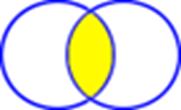
The area in yellow describes the amount of information that you would find in combining the subjects of "women" AND "AIDS." You will find results that have both terms in common.
If you find that you are retrieving fewer results/less information than you would like, try using "or" in combining concepts.
AIDS OR Women
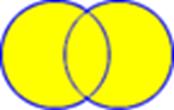
All of the area in yellow represents the information you would get by combining "women" OR "AIDS."Or" will find each term separately or together.
Truncation is like a wildcard. Added to the stem of a word, it will find that stem plus anything that comes after it.

The symbol used to truncate a word depends upon the database or search engine you are using. For example, the truncation sign in many databases is *. As a result, a search term "sex*" will return records on sex, sexual, sexuality.
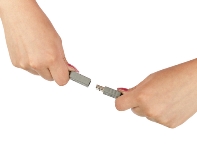
Whenever you are searching for a topic and the topic is composed of two or more words strung together (like "bird flu," "health care reform," or "global warming,"), put the words within quotes, so that you will retrieve items that are related to the whole phrase, not just to each word individually.
Here is a short video on the characteristics of databases and how to search them from Butler Community College Library. The first few seconds will address only users of that particular library, but the rest of the content describes common characteristics of most Library databases.
If you are in the Library, be sure to wear headphones to hear the sound in the video below.
Also, to see the full screen clearly, click on the YouTube logo on the bottom right, run your cursor along the bottom edge of the video screen, and click on the ![]() symbol. When you are finished viewing, close the YouTube tab to get back to this page
symbol. When you are finished viewing, close the YouTube tab to get back to this page
© 2011 Butler Libraries


Research Databases

The Library provides dozens of online databases that cover almost every subject. These databases contain thousands of authoritative, full text reports, books, and articles, including peer-reviewed articles from scholarly journals.
To access Library databases:
Go to http://www.frederick.edu/student-resources/learning-commons/library.aspx, then click on Research Databases.
· From ON-CAMPUS: No login needed.
· From OFF-CAMPUS:
Students: enter your myFCC Username and Password when prompted.
Your Default myFCC Username is the letter W plus your student ID number. (Example: W1234567)
If you haven't changed your password, your Default Password is the first two letters of your last name plus the last five digits of your student ID number (Example: sm34567).
Faculty/Staff: Use your Network Username and Password when prompted.
If you are still having problems accessing the databases, we recommend that you reset your password using the "Reset My Password" link found on the log-in page and try to access the databases again.
Link to our Research Databases: http://guides.frederick.edu/az.php
Gale Virtual Reference Library (GVRL) is a collection of electronic subject encyclopedias just right for getting background information on your topic.
Here is a demonstration of GVRL. Be sure to wear headphones to hear the sound in the video below if you are in the Library.
Also, to see the full screen clearly, click on the YouTube logo on the bottom right, run your cursor along the bottom edge of the video screen, and click on the ![]() symbol. When you are finished viewing, close the YouTube tab to get back to this page.
symbol. When you are finished viewing, close the YouTube tab to get back to this page.
c. 2014 Gale/Cengage
Once you've searched and found an article you can use, click on the title of the article, then click on Citation Tools:
Here are the elements of your citation:
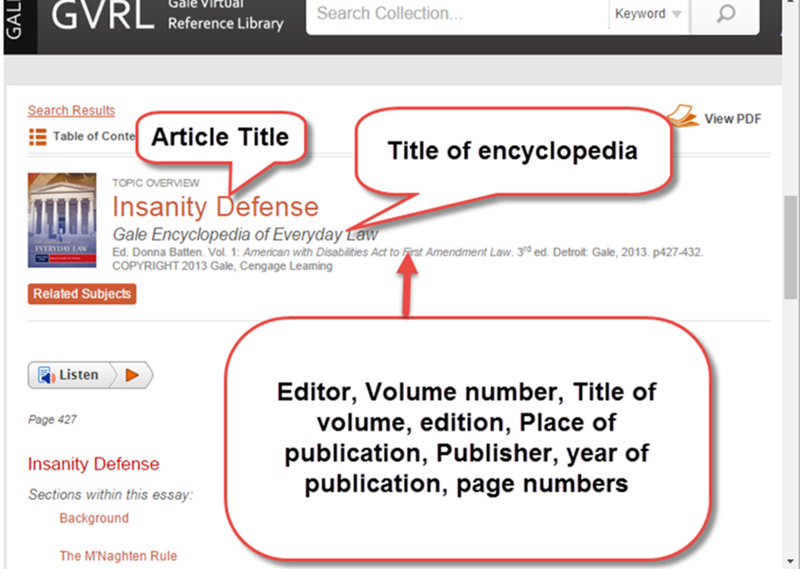
Your citation is pictured below:
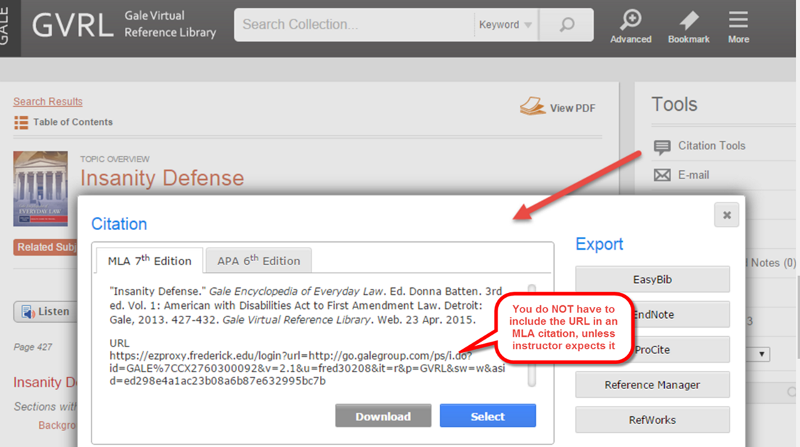
Copy and paste the citation into your Works Cited List (MLA) or your References List (APA) or use one of the citation programs, like EasyBib, if you have access.
In addition, the Library has style manuals to help you format your citations, there are guidelines for and examples of the different styles in the "Why and How to Give Credit" lesson in the Virtual Library Orientation, there is a section in our Writing Center Research Guide that can help, or you can submit an Ask a Reference Librarian form.
This database contains news articles and other documents from Issues and Controversies on File.
If you are in the Library, be sure to wear headphones to hear the sound in the video below.
Also, to see the full screen clearly, click on the YouTube logo on the bottom right, run your cursor along the bottom edge of the video screen, and click on the ![]() symbol. When you are finished viewing, close the YouTube tab to get back to this page.
symbol. When you are finished viewing, close the YouTube tab to get back to this page.
© 2014 RMU Library
The screen capture below shows an example of the information you'll need to cite a document from Issues and Controversies on File
![]()

Issues and Controversies on File also gives you a tool to cite its articles:
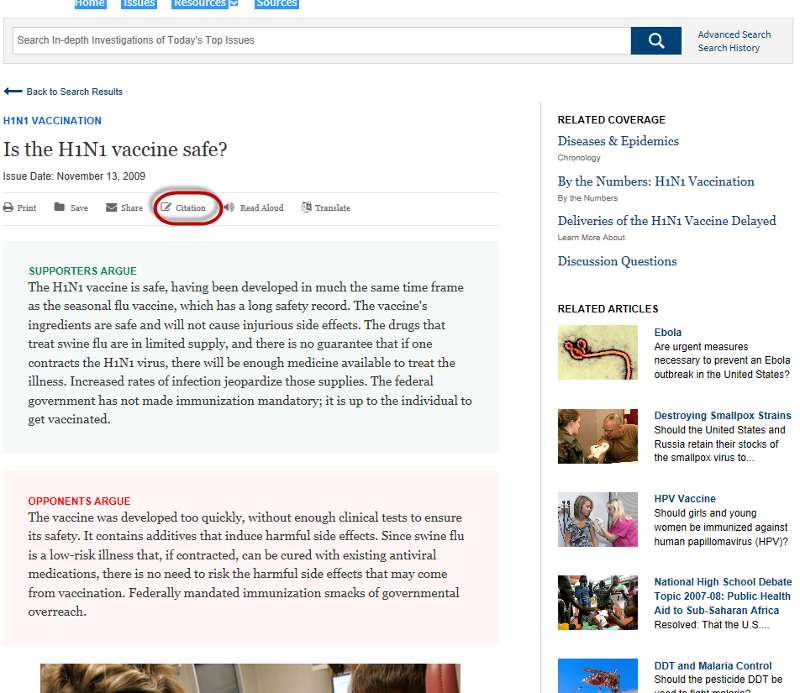
Here is the citation:

Remember, also, that the Library has style manuals to help you format your citations, there are guidelines for and examples of the different styles in the "Why and How to Give Credit" lesson in the Virtual Library Orientation, there is a section in our Writing Center Research Guide that can help, or you can submit an Ask a Reference Librarian form.
CQ Researcher includes full-length articles on important issues of the day, including an overview, chronology, pro/con feature, and additional resources for research.
Be sure to wear headphones to hear the sound in the video below if you are in the Library. Also, to see the full screen clearly, click on the YouTube logo on the bottom right, run your cursor along the bottom edge of the video screen, and click on the ![]() symbol. When you are finished viewing, close the YouTube tab to get back to this page.
symbol. When you are finished viewing, close the YouTube tab to get back to this page.
© 2013 Sage
The screen shot that follows shows the elements you'll need to have to cite a report from CQ Researcher:
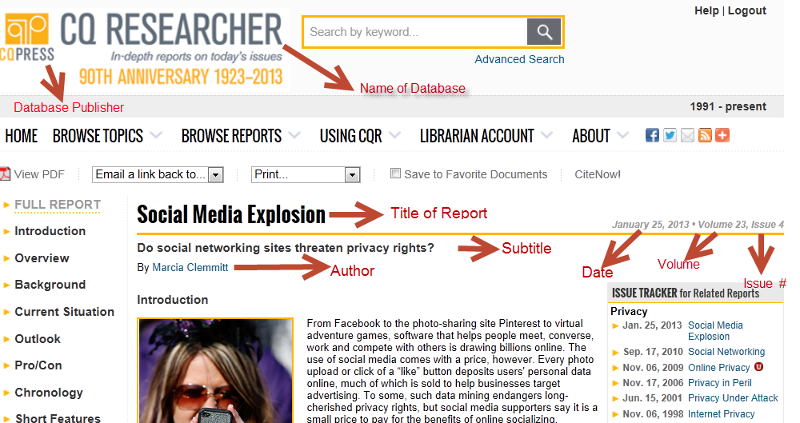
CQ Researcher also gives you help in citing its information:
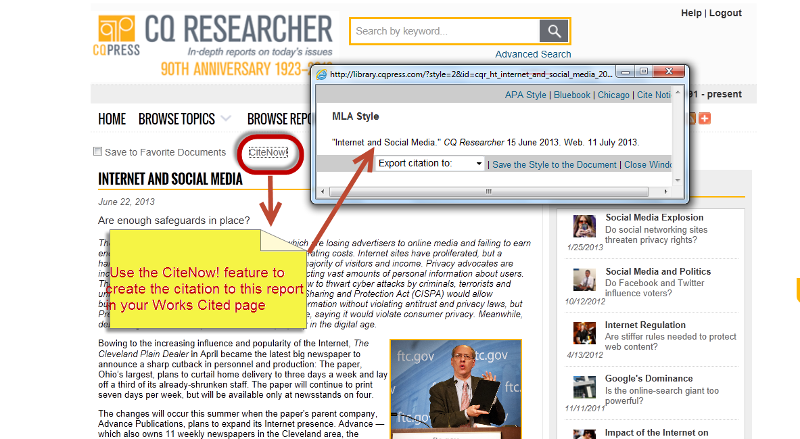
You'll recall that the Library has style manuals to help you format your citations, there are guidelines for and examples of the different styles in the "Why and How to Give Credit" lesson in the Virtual Library Orientation, there is a section in our Writing Center Research Guide that can help, or you can submit an Ask a Reference Librarian form.
Here is a demonstration of Opposing Viewpoints, summaries of information and argument/position papers on both sides of controversial issues.
Be sure to wear headphones to hear the sound in the video below if you are in the Library.
Also, to see the full screen clearly, click on the YouTube logo on the bottom right, run your cursor along the bottom edge of the video screen, and click on the ![]() symbol. When you are finished viewing, close the YouTube tab to get back to this page
symbol. When you are finished viewing, close the YouTube tab to get back to this page
© 2015 GaleCengage
Here is a review of the elements you will need to cite your source(s) from Opposing Viewpoints in Context:
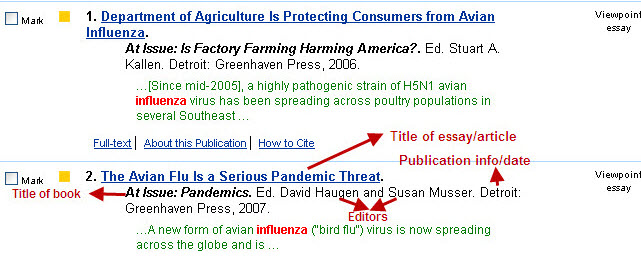
Opposing Viewpoints in Context has a citation tool that is built into the database:
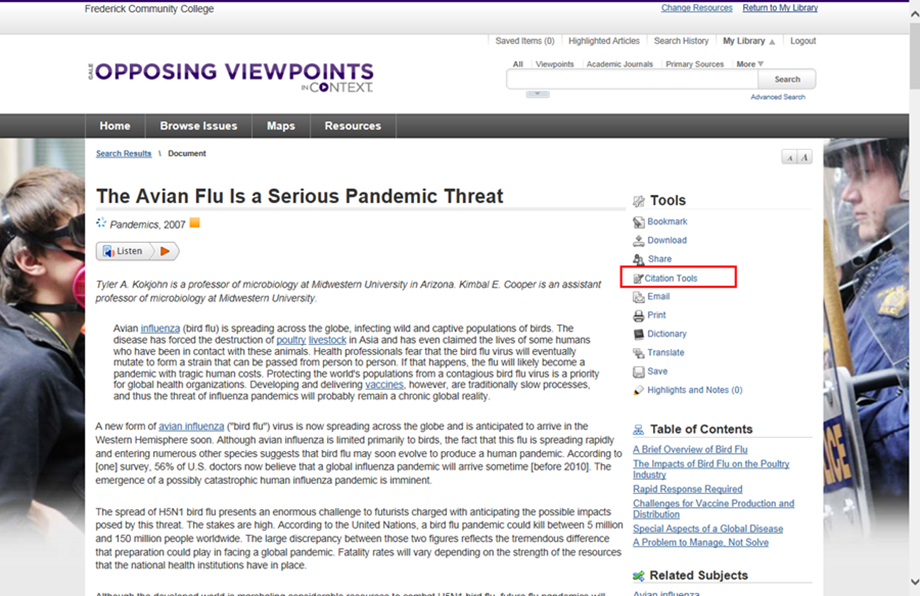
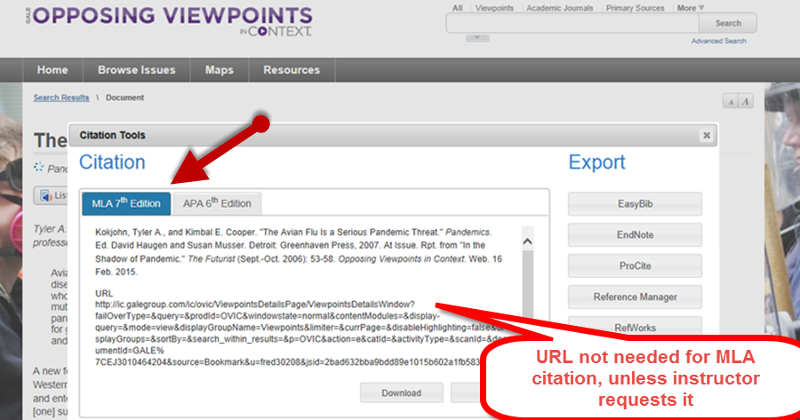
Copy and paste the citation into your Works Cited List (MLA) or your References List (APA) or use one of the citation programs, like EasyBib, if you have access.
Remember, also, that the Library has style manuals to help you format your citations, there are guidelines for and examples of the different styles in the "Why and How to Give Credit" lesson in the Virtual Library Orientation, there is a section in our Writing Center Research Guide that can help, or you can submit an Ask a Reference Librarian form
EBSCOhost has several databases with thousands of full-text general, education, medical, and business articles and documents.
Here is a video on the basics of searching the EBSCOhost databases. If you're in the Library, be sure to wear headphones to hear the sound in the video below.
Also, to see the full screen clearly, click on the YouTube logo on the bottom right, run your cursor along the bottom edge of the video screen, and click on the ![]() symbol. When you are finished viewing, close the YouTube tab to get back to this page.
symbol. When you are finished viewing, close the YouTube tab to get back to this page.
© 2014 EBSCOhost
Here's a reminder of the information you'll need to cite an article from EBSCOhost: Academic Search Premier:

The EBSCOhost databases give you help in citing information from them:
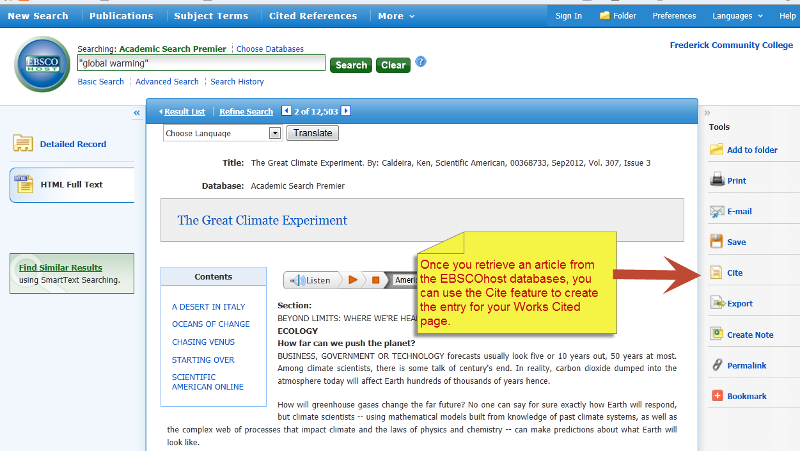
Here is the citation:
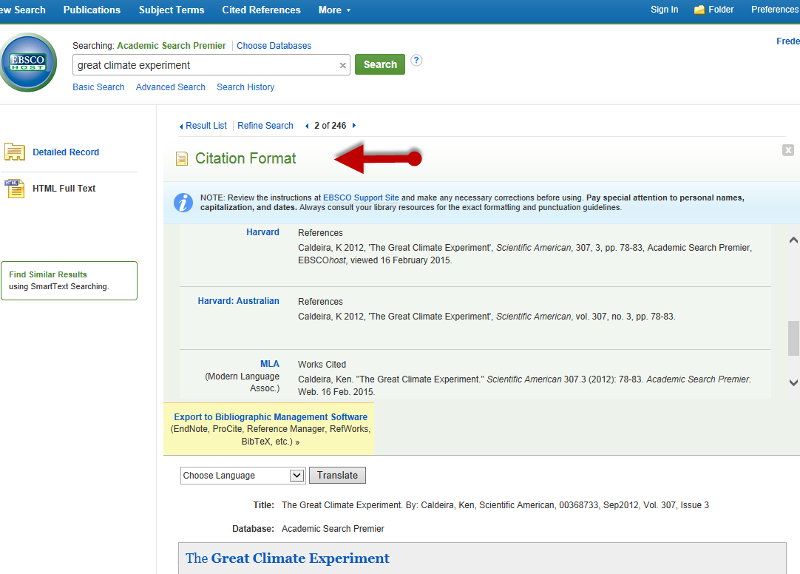
Remember that the Library has style manuals to help you format your citations, there are guidelines for and examples of the different styles in the "Why and How to Give Credit" lesson in the Virtual Library Orientation, there is a section in our Writing Center Research Guide that can help, or you can submit an Ask a Reference Librarian form.

Our JSTOR collection includes scholarly journals in history, political science, sociology, math, statistics, and the other arts, humanities, and social science fields.
NOTICE: If this image,  , is displayed next to an article, that article is not available to read for free. All of these titles have an embargo of two or more years—meaning that the publishers give access only to articles that are two or more years behind the most current issue. So you wouldn't use JSTOR if you wanted the most current info; we've got plenty of other databases for that. Consequently, this is not a problem for many searches on scholarly subjects.
, is displayed next to an article, that article is not available to read for free. All of these titles have an embargo of two or more years—meaning that the publishers give access only to articles that are two or more years behind the most current issue. So you wouldn't use JSTOR if you wanted the most current info; we've got plenty of other databases for that. Consequently, this is not a problem for many searches on scholarly subjects.
Here is the opening screen of JSTOR:
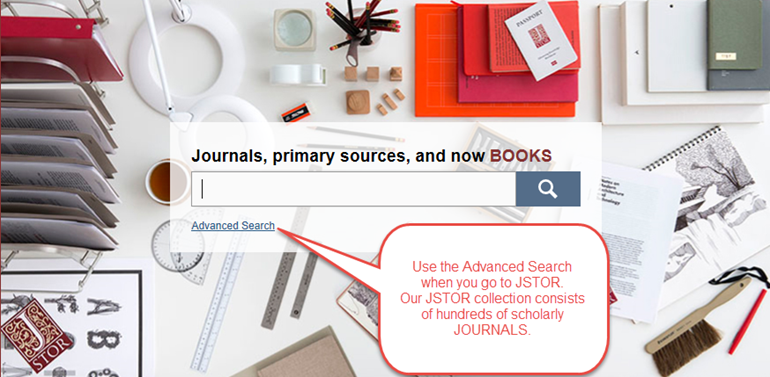
Here is the Advanced Search screen:
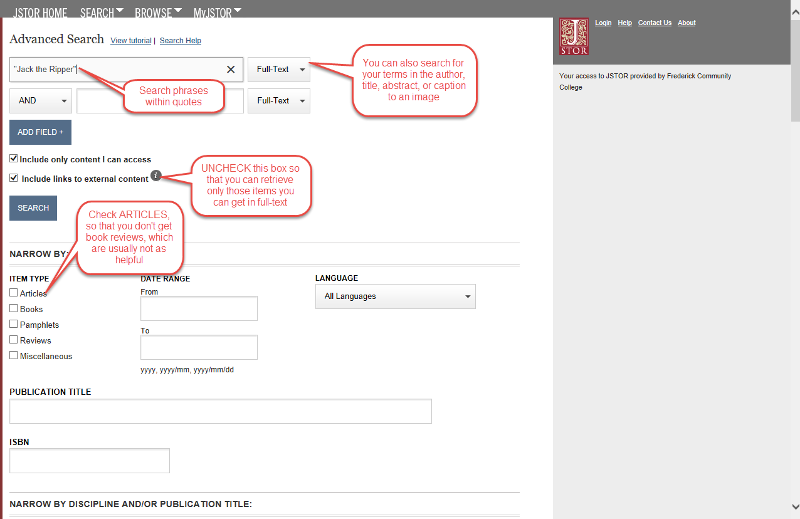
Here is the results of our search for articles on Jack the Ripper.
Again, remember that the Library has style manuals to help you format your citations, there are guidelines for and examples of the different styles in the "Why and How to Give Credit" lesson in the Virtual Library Orientation, there is a section in our Writing Center Research Guide that can help, or you can submit an Ask a Reference Librarian form.
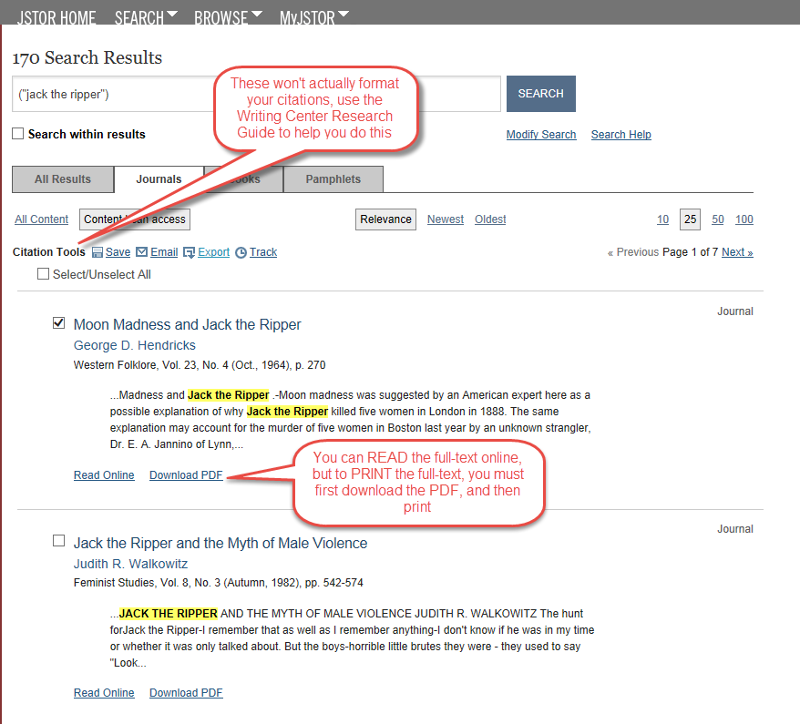
Users can find information on everything from the music industry to gun control to worldwide poverty rates. Data charts are customizable as to chart type (bar graph, line chart, etc),
colors, and labeling. Statista also includes a built-in citation tool. Here is a video on the basics of using Statista; use headphones if you are in the Library.
Also, to see the full screen clearly, click on the YouTube logo on the bottom right, run your cursor along the bottom edge of the video screen, and click on the ![]() symbol. When you are finished viewing, close the YouTube tab to get back to this page.
symbol. When you are finished viewing, close the YouTube tab to get back to this page.
©StatistaGmbh 2014
Here is a screen showing the results of a simple search on statistics for the Ebola virus outbreak:
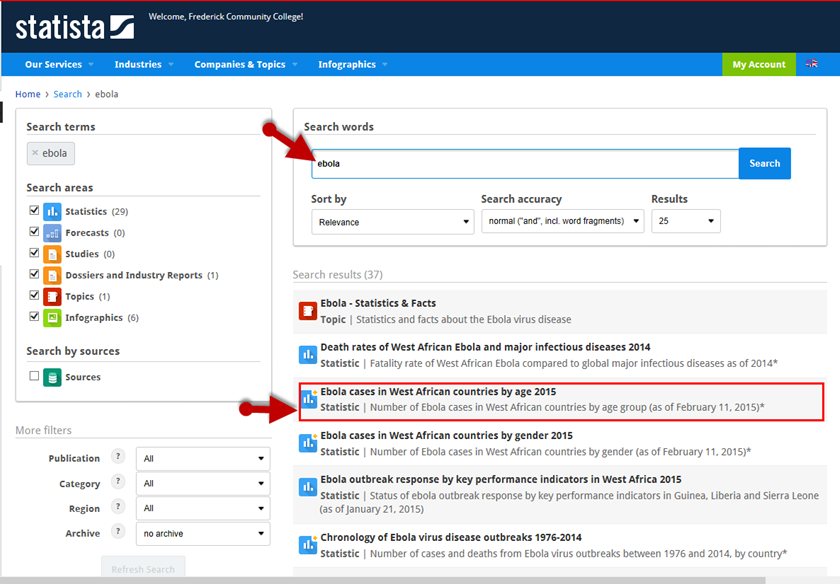
Here you can see the statistics and the citation (in this case, MLA) for the information:
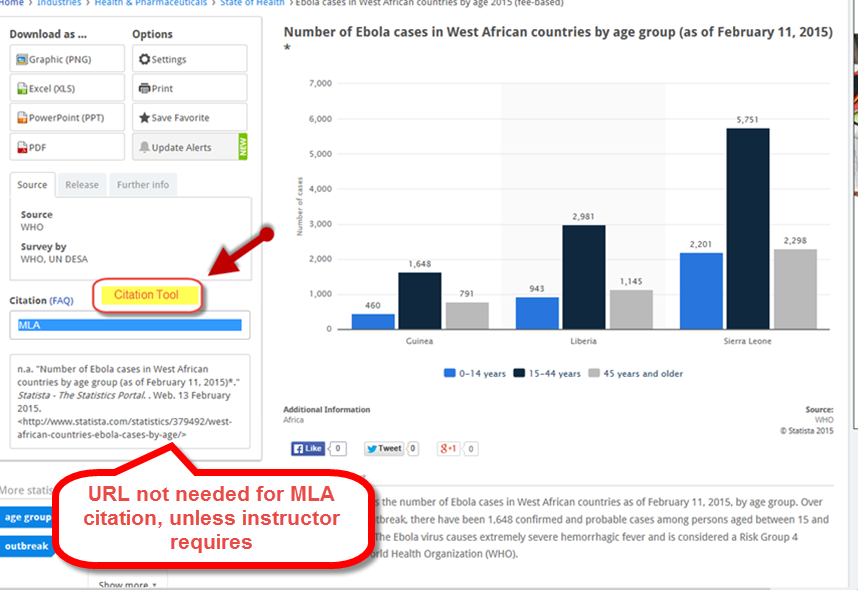
Copy and paste the citation into your Works Cited List (MLA) or your References List (APA) or use one of the citation programs, like EasyBib, if you have access.
Library Research Guides Put it All Together!
Library Research Guides made their debut on FCC's Library website in 2012. These librarian-created Guides steer you towards the best books, databases, and websites for your needs, and help you build a research strategy that is systematic and thorough.
To get to the guides, go to the Library's home page, http://www.frederick.edu/student-resources/learning-commons/library.aspx, and click on Research Guides. The portal to the Guides is shown below:
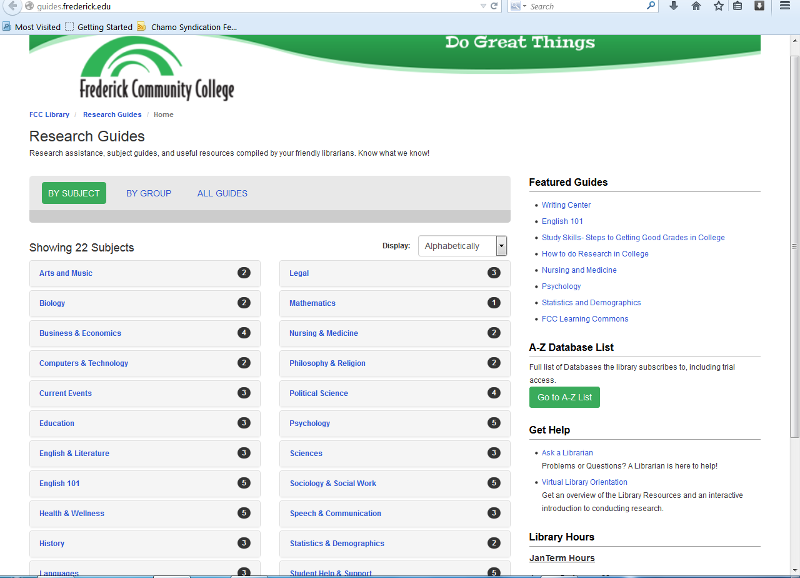
Come in and speak with a Librarian or email us at Ask a Reference Librarian. We'll be glad to help you find the best information for your paper or project.

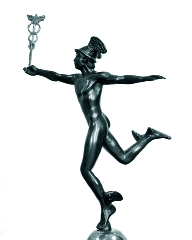
If the FCC Library doesn't have the books or articles that you need, we offer a service called, "Interlibrary Loan," whereby we can get copies of materials for you. Just ask for help at the Welcome Desk, call 301-846-2444, fill out and send the online request form for books or for magazine/journal articles or email Patty Furry-Hovde, [email protected].